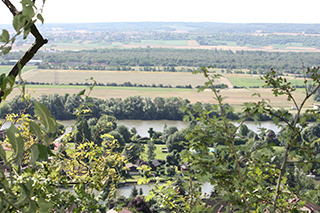Prochain point : lat="48.99871" lon="1.872605"

Panorama from le Gibet
Advance defence post of the counts of Meulan
In the tenth century an advance defence fortification stood here to protect Meulan against invasions. Mentioned in 1030 as a possession of the Count of Meulan, Mézy-sur-Seine was administered by viscounts. In 1204, the County of Meulan was attached to the crown of Philip Augustus and the viscounts become the "Vicounts of Mézy."
In the thirteenth century a large perimeter wall was built together with a wooden fence surrounded by ditches. There was also a keep and a tower called the “Bertaudiere" which has since disappeared. This was the command post for the whole defence system. In the seventeenth century, Mézy-sur-Seine spread to higher ground. The soil was very fertile and suitable for a wide variety of crops. At that time, wine growing was at its peak. Indeed the village was built on a south -facing hill, favourable to vine growing. Moreover, some of the winegrowers’ houses still remain in the small streets. The vines were gradually replaced by crops of early variety peas. An important event in the history of Mézy-sur-Seine in the eighteenth century was the construction of the Royal Road from Paris to Rouen, which opened up the village.
The place known as the Gibbet...
Gibbets or gallows were stone pillars with a large wooden crossbar from which, before 1789, criminals were hanged. Placed on high ground to be in full view, gibbets indicated the seat of High Justice. The number of stone pillars indicated the title of the holder (8 for dukes, 6 for counts, 4 for barons, 3 for lords). In the Middle Ages, brigands and the poor devils who stole bread were as likely to be hanged. This area has always been known as "The Gibbet", because it was below this house that the old gallows once stood, now symbolized by a group of trees at the top of the village. There is also a place in Mézy called "La Justice". Although quite far from the gibbet, it was clearly a place of detention.
From the "Gibbet", you can see the green island below, the private property where the “Parisians” come to seek out the peace and quiet of their holiday chalets. An agricultural plain spreads out on the other side of the Seine with wellfields for drinking water. There were plans to build a Formula 1 racing circuit there but the project was abandoned in 2009. Finally, the land is once again being used for organic farming and a vegetable processing facility has been set up there.





